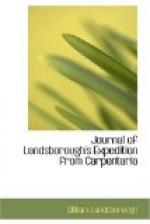February 27. Number 14 Camp, situated on the right bank of the Flinders River at a point about seven miles south-east and by south from Fort Bowen.
The weather during the night was showery, accompanied by northerly wind. Left camp at 8.40. At 10.5, having crossed a plain in sight of the trees on the banks of the river in an easterly course for three and three-quarter miles, sighted hills, named by me Mount Brown and Mount Little. At 11.40 came south-east and by east towards Mount Little for four and a half miles, and reached a watercourse full of water from the east. At 12.15, having come one and a half miles further in the same direction, we halted till 12.30 for Jackey, who had gone to waterholes surrounded by springs and clumps of tea-trees for the purpose of shooting ducks. Jemmy and I left the party to ascend Mount Little, which is nearer to the river than Mount Brown. We reached Mount Little in about a mile and rode to its rocky summit. Its elevation is about fifty feet. The rocks looked like granite, but on a closer inspection I found they were of a stratified formation. From the mount nothing was observable except Fort Bowen, Mount Brown, a little rise, and extensive thinly wooded plains. Fort Bowen bore 58 degrees west of north, the small rise south and by east. I built here a small cairn and scratched with a mussel shell which I picked up at a blacks’ camp (having no knife) my initials and a broad arrow. Started again at 1.30 after the rest of the party, who had gone on ahead. At 2.30 came south and by east half east, partly on the tracks and partly with the main party, over thinly wooded plains for four miles. At 2.30 came south one and three-quarter miles and encamped. I never saw finer-looking herbage than that along our path today. If it always rained when the grass required moisture this would be one of the best places, if not altogether the best, in Australia.
February 28. Camp 15, situated on the right bank of the Flinders River at a point about six miles south and by east from Mount Little and Mount Brown.
Near this point the water in the river is deep with tea-trees growing near, a good sign that the water is permanent. Last night we had a sudden and heavy shower of rain. Fisherman and Jackey were not prepared for it, consequently they got all their clothes and bedding wet; this however was rather a subject of merriment than otherwise. We left camp at 8.8. At 8.55, having come east-south-east for two miles up the river, over rich level ground, thinly wooded with box and (what I take to be) excoecaria, and green with the following herbage: roley-poley, pigweed, saltbush, and grass to plains. At 11.15 came five and three-quarter miles in the same direction across plains intersected from the east by shallow watercourses, outlets of the river during floods. At 12, having remained behind the party with Jemmy, I got the following observation on a plain horizon of about a mile in length, namely, meridian altitude




